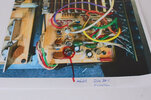Glad to join your community here. As many others have found when refurbing certain Yamaha auidio components certain transistors are no longer available. Specifically the 2SK78c (TO92 package ) FETs in the Yamaha C1 preamp. I've been unable to find even the operating parameters for this FET . Would anyone here at least have that kind of information ? These FETs are used in some buffer circuits and equalization circuits in the C1. Hoping to use certain fets made by NTE but without the specific parameter information it will be difficult to determine how to procede. Thanks in advance for any info or leads. Cheers, Mike


